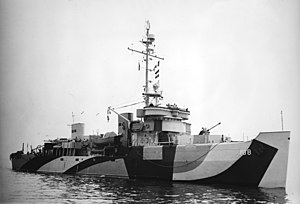
USS Mertz (DD-691) was a Fletcher-class destroyer in the service of the United States Navy from 1943 to 1946. She was scrapped in 1972.
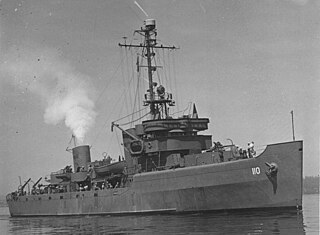
USS Revenge (AM-110) was a World War II-era Auk-class minesweeper in the service of the United States Navy. It was the sixth United States vessel named Revenge.
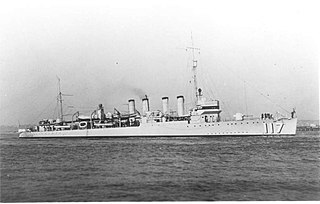
USS Dorsey (DD–117), reclassified DMS-1 on 19 November 1940, was a Wickes-class destroyer in the United States Navy during World War I. She was named for John Dorsey.

USS Hogan (DD-178/DMS-6) was a Wickes-class destroyer in the United States Navy during World War II.

USS Howard (DD–179), (DMS-7) was a Wickes-class destroyer in the United States Navy during World War II. She was named for Charles W. Howard, who was killed in the American Civil War aboard USS New Ironsides.
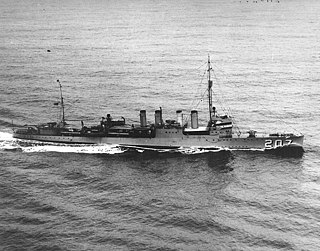
USS Southard (DD-207/DMS-10) was a Clemson-class destroyer in the United States Navy during World War II. She was the second Navy ship named for Secretary of the Navy Samuel L. Southard (1787–1842).

USS Zeal (AM-131) was an Auk-class minesweeper that served in both World War II and during the Korean War. As a steel-hulled fleet minesweeper, she was assigned to support the fleet by removing enemy mines whose purpose was to impede the path of the U.S. Pacific Fleet.
USS Dutton (AGSC-8/AGS-8), originally PCS-1396, was a PCS-1376-class minesweeper built for the United States Navy during World War II that was later converted into a survey ship. She was the first US Navy ship to be named in honor of Benjamin Dutton, Jr.

USS Shelter (AM-301) was an Admirable-class minesweeper built for the United States Navy during World War II. After service in the Pacific during World War II, Shelter was decommissioned in June 1946 and placed in reserve. In January 1964, she was transferred to South Vietnam for service in the Republic of Vietnam Navy as RVNS Chi Linh (HQ-11). She remained in South Vietnamese service until the collapse of that country in 1975. Chi Linh was one of several ships that fled from South Vietnam to the Philippines. She was then commissioned into the Philippine Navy in April 1976 as RPS Datu Tupas (PS-18), named after a chieftain of Cebu. The ship's fate is not reported in secondary sources.

USS Sheldrake (AM-62/AGS-19) was an Auk-class minesweeper built for the United States Navy during World War II. The ship was named after the sheldrake duck. The ship earned four battle stars during World War II. She was converted to a survey ship and re-designated AGS-19 in 1952 and remained in commission until 1968. She was sold for scrap in 1971.

USS Starling (AM-64) was an Auk-class minesweeper acquired by the United States Navy for the dangerous task of removing mines from minefields laid in the water to prevent ships from passing.
USS Heed (AM-100) was an Auk-class minesweeper built for the United States Navy during World War II. She earned five battle stars for her World War II service. She was recommissioned during the Korean War. She was placed in reserve in 1954 and remained there until struck from the Naval Vessel Register in 1967.

USS Triumph (AM-323) was a World War II Auk-class minesweeper of the United States Navy.
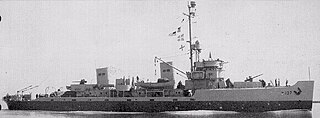
USS Prevail (AM-107) was an Auk-class minesweeper acquired by the United States Navy for the dangerous task of removing mines from minefields laid in the water to prevent ships from passing.

USS Requisite (AM-109) was an Auk-class minesweeper acquired by the United States Navy for the dangerous task of removing mines from minefields laid in the water to prevent ships from passing.

USS Sage (AM-111) was an Auk-class minesweeper acquired by the United States Navy for the dangerous task of removing naval mines.
USS Token (AM-126) was an Auk-class minesweeper acquired by the United States Navy for the dangerous task of removing mines from minefields laid in the water to prevent ships from passing.
USS Tumult (AM-127) was an Auk-class minesweeper acquired by the United States Navy for the dangerous task of removing mines from minefields laid in the water to prevent ships from passing.
USS Design (AM-219) was a steel-hulled Admirable class minesweeper built for the U.S. Navy during World War II. A crew, trained in minesweeping, boarded the new vessel, and proceeded to the Pacific Ocean to clear minefields so that Allied forces could safely invade Japanese-held beaches. For this dangerous work under combat conditions she was awarded three battle stars.

USS Serrano (ATF-112) was an Abnaki-class tug of the United States Navy. She was laid down on 6 March 1943 by the United Engineering Co., Alameda, California, United States, and launched on 24 July 1943, sponsored by Mrs. Sidney E. Fraser. Serrano was commissioned on 22 September 1944. After six years of service, Serrano was decommissioned in 1950. After spending ten years in reserve, she was reactivated, converted to a surveying ship and re-designated AGS-24. She served in that role until 1970.
